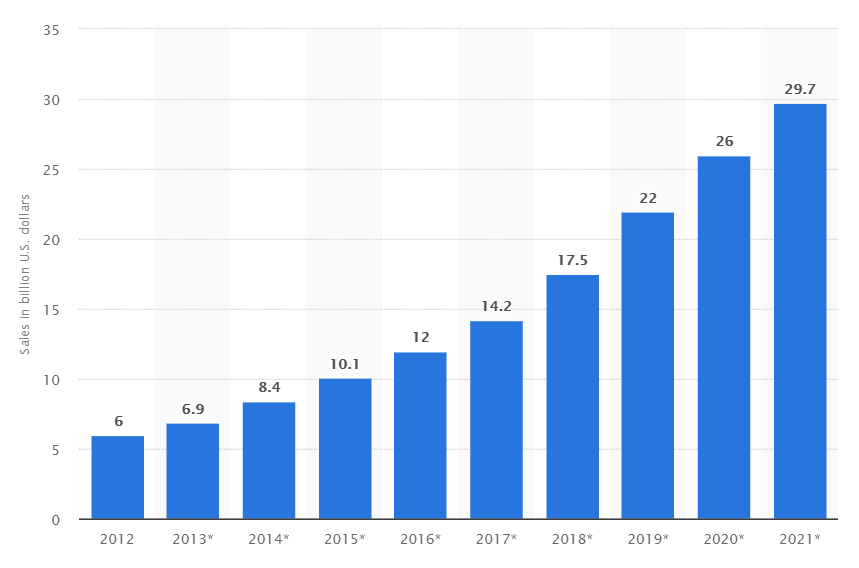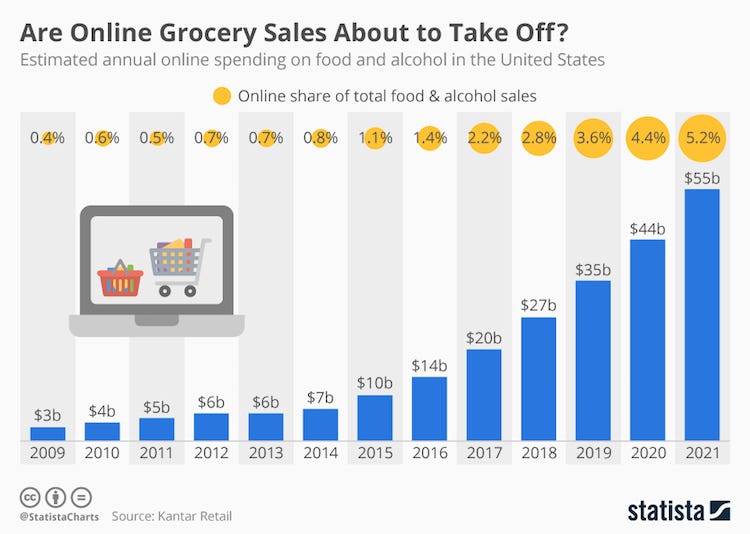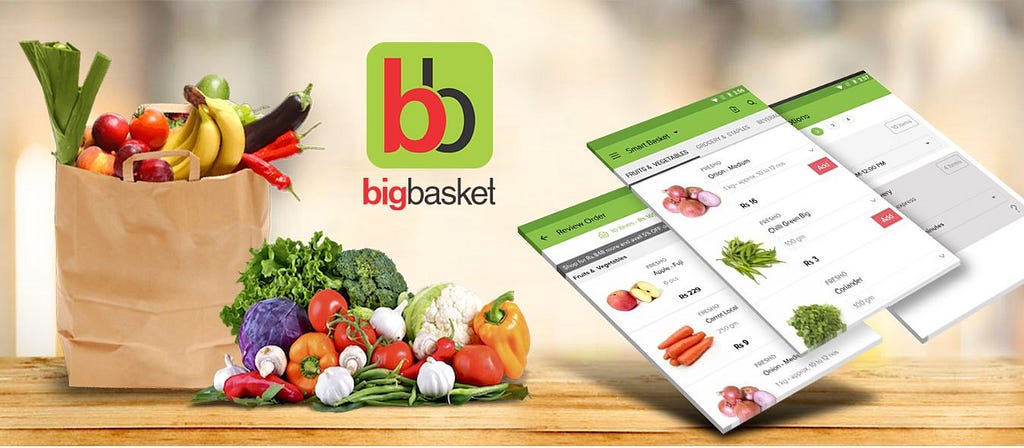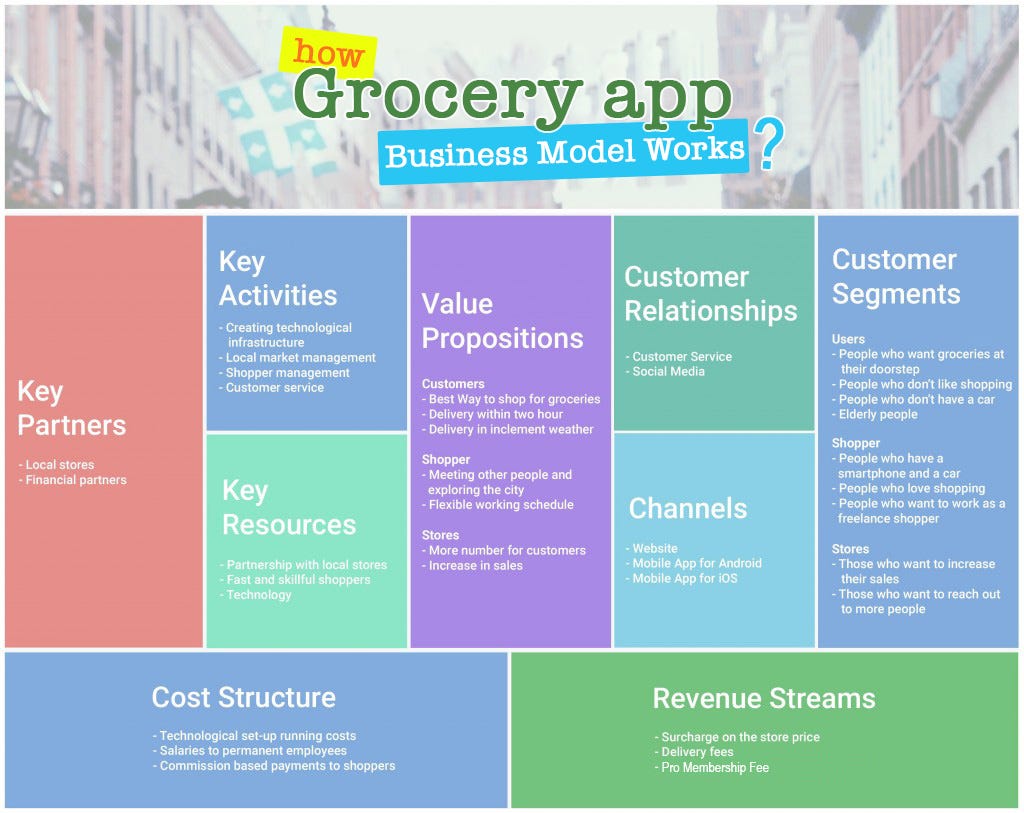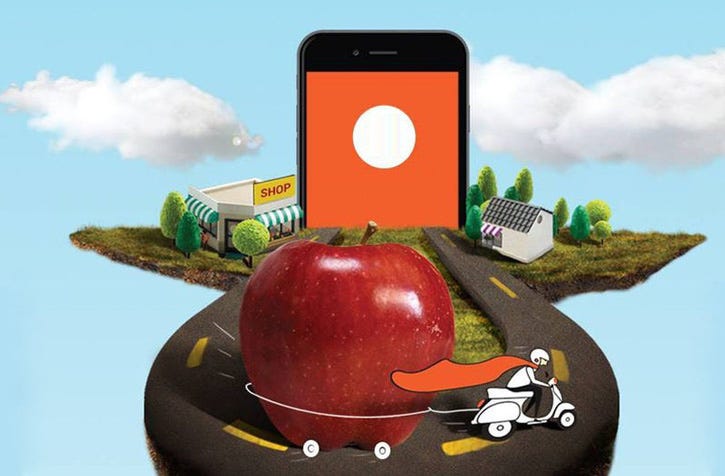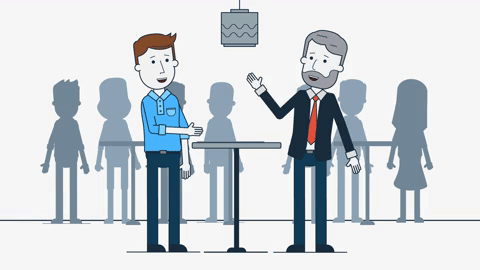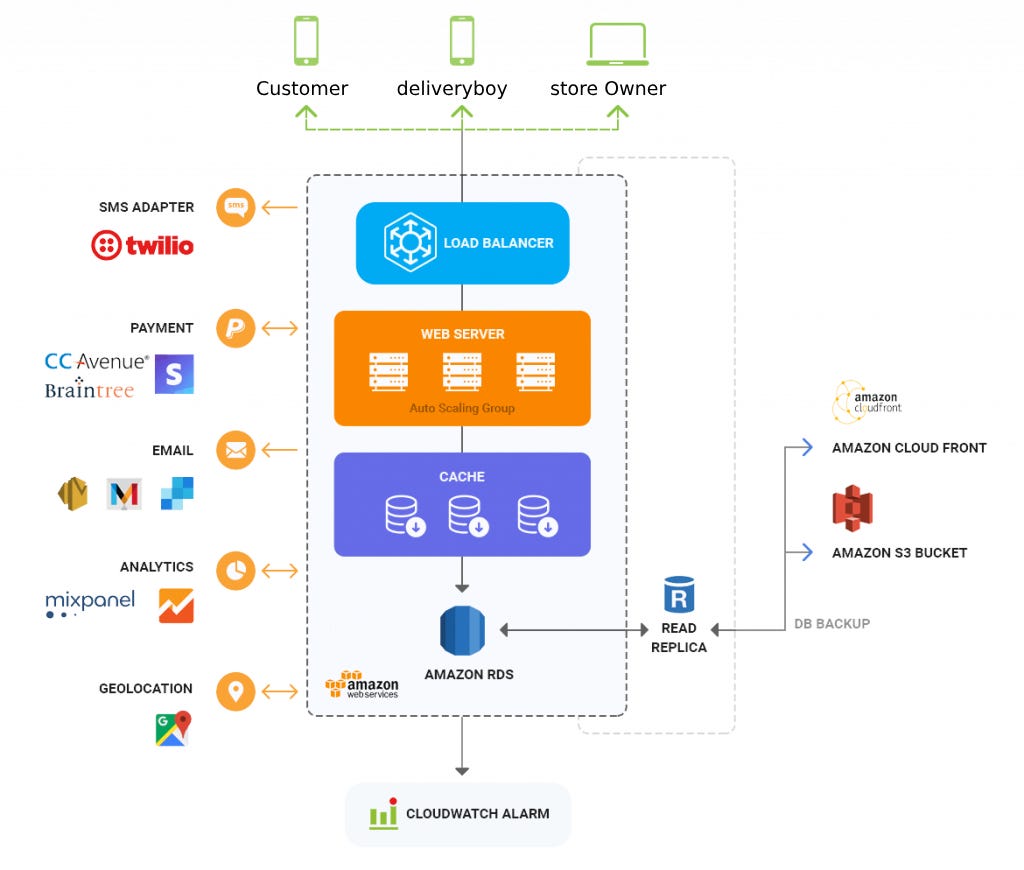Latest news about Bitcoin and all cryptocurrencies. Your daily crypto news habit.
Grocery delivery applications are becoming widely popular at present. The customer has switched themselves from the traditional system opining “No more trolley picking, I want it to be delivered at my home”. For a matter of fact, almost 48% of people are buying grocery through online or application medium in which almost one-fifth people are aged 25 to 34. Surely, it is picking an up-trend and the main and simple reason for its growth is the convenience of buying and accessibility to over a wide range of products which might otherwise not be available at your nearest store. We will have a look at a few of the consumer behavior trend that has infused a positive growth into it.
Online grocery shopping sales in the United States from 2012 to 2021
=> Major sales of the delivery companies came from the mobile devices that point towards an increase in M-commerce. More of such purchases are a result of what is known as the impulse purchase attitude driven inside customers
=> With the advent of busy lifestyle and schedule, the online purchase of grocery is going on a record high with time. People prefer not to go on a store but rather prefer the grocery providers offer them the best of services while the purchase of grocery
India’s Answer: Big basket
BigBasket.com is India’s biggest online grocery store and enables a customer to leave the drudgery of shopping for food and welcome a simple easy method for perusing and looking for basic needs. The organization as of now works from Bangalore, Mumbai, and Hyderabad and has a varied portfolio that conveys in excess of 12,000 items and more than 1,000 brands.
The basic grocery retail store in India is developing at around 10% CAGR and is about USD 400 Billion in size while e-basic need records to just 0.1%. Inside this, the online basic supply showcase is relied upon to be about USD 10Billion in the following years. A greater part of this market is probably going to be amassed in the urban areas in the nation.
In 2014, there were various new companies, for example, ZopNow, Aaram-Shop, and Farm2Kitchen in this classification with every city having different neighbourhood players. The vast majority of them were not ready to manage because of different business and operational reasons, some which are as of now surely understood. The victor in this class will be one who tends to the different difficulties in conveying an incredible support of the client.
Types of Grocery Apps in the Market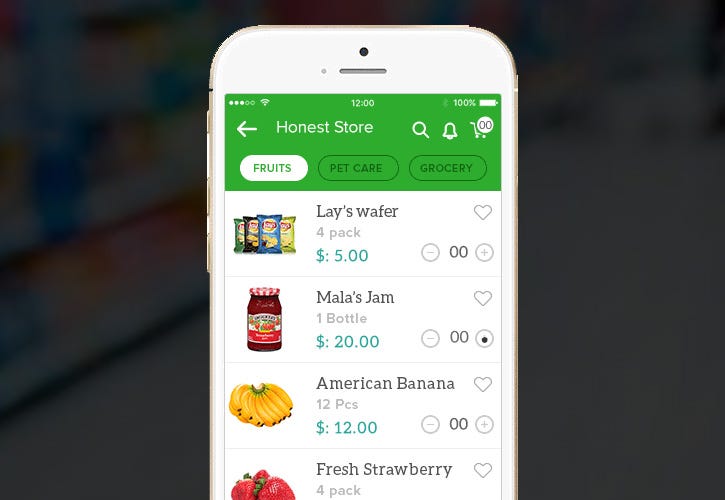
Grocery chainsA staple chain, for instance, Wal-Mart, has a tendency to have its own on-request versatility arrangement, or, in other words, a solitary store at smaller scale level activities.
AggregatorAggregators essentially list adjacent supermarkets to a client. The client can choose one of the close-by supermarkets recorded on the application. From the online menu, he can include whatever he needs in any amount to the truck. He looks at with the truck, makes the payment with different accessible choices, and sits tight for the store to affirm the request. When the request is affirmed, he can track his request continuously until the point that it reaches his place. The obligation to convey the orderlies exclusively with the store proprietor; the aggregation only records the store and its menu on its stage.
MarketplaceA marketplace supermarket is very like a market collection stage; aside from the commercial center has its very own group of conveyance young delivery men to convey requested goods to the clients’ homes by methods for a retail mobility arrangement. It is important to know whether a particular commodity in demand may be fulfilled within the stipulated time or not.
Single storeIn a single store application, the owner of the grocery shop needs proprietor commissions his very own branded application and deals with everything, from keeping up the application and keeping a refreshed online menu to conveying the request to a client and gathering cash. Certainly, this method is in its best of current use as a lot of the commission depends upon the quantity of business that is acquired from the market.
Grocery Delivery Business Model Like Big Basket
Big Basket constructs its success in light of the three columns to be specific outstanding customer center. Big basket offers same-day conveyance over a city, 99.3% on-time conveyance, 99.5% request fill rate and a no inquiries asked client merchandise exchange, all of which has added to high customer reliability and great client input. Basic grocery business in India is a 400 billion dollar addressable market in which e-grocery need represents just 0.1%. huge bushel keeps on scaling when many new businesses are eliminating their working expenses and closing activities in numerous land areas.
Over everything, Big Basket repays a client each time it can’t convey on its guarantee in this way guaranteeing there is a reliable spotlight on increasing present expectations higher. Wide range and an assortment of items (They have over 40% of their business getting through their very own brands. It works on an edge of 25% on different items and more than 35% for in-house marks. Big Basket has additionally improved by offering items, for example, cut foods grown from the ground, a scope of formula blends and have as of late propelled their very own pastry shop in Bangalore that conveys bread heated to arrange) and persistent development with the assistance of innovation.
There are organizations at present adopting a warehouse based model. Possessed, out of town, mechanized distribution center’s stock tremendous amounts of items, and a fleet of refrigerated vans convey basic supplies to buyers on a schedule opening premise. A costly model, which 24-hour conveyance offering isn’t quick or sufficiently flexible for new customers described previously.
Also in use by the multichannel players are the dark stores, nearby, littler distribution centers where devoted staff called “pickers” collect requests to hand over to conveyance drivers. Services show signs of improvement, as clients can be delivered quicker, and the stock is more streamlined by demand. It’s still extremely costly to account monstrous real estate ventures to just online deals, which are as yet not so big contrasted with in-store.
However, at present, the ship from the store model is picking up fast. In this model, all you need to do is to give your customer what they need whenever they need without much worrying about the warehouse. We will have a look at some of the features of such a model:
1. Giving the same day deliveryOne of the most delightful yet hard to achieve features. New customers want to purchase littler bushels, all the more every now and again: it’s vital they get it now. In this manner, there’s no requirement for putting resources into claimed huge vans, if an armada of bikes (or most extreme, autos) can carry out the activity snappier and better.
2. Customer EngagementIt is one of the important activities if you want to sustain your acquired customer for a longer period of time. The grocery players should use mark value and showcasing spending plans to give extraordinary quality and a wide choice of items, together with focused advancement. Also, involving in their daily activities is basic to it
3. Warehousing the shop storeSince stores are nearer to clients, new customers will sit tight less for conveyance, as inclusion is slender all through the city. Likewise, costs diminish while income and edges increment because of stock advancement.
4. Streamlining the logisticsThere is a strong need to arrange all the operational activities and set it as per the demand. Store pickers ought to collect online requests appropriate from stores’ passageways by examining the items and giving them over to drivers.
Typical features of an on-demand grocery app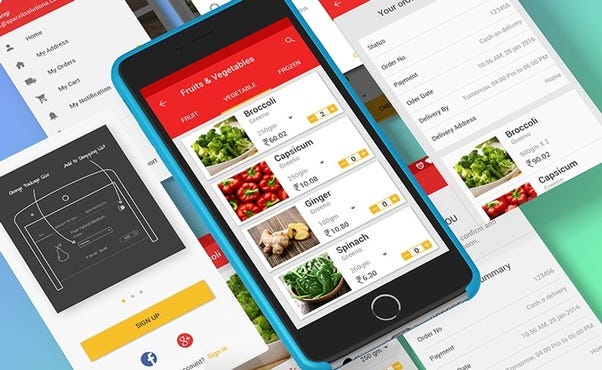
Identification Factors: To briefly know about the customer and keep details as required
- Social Sign-up/Sign-in
- User Profile Management
- Forgot Password
- Verify email and Phone Number
Operational Features: Features that lead to a smooth shopping experience getting the right one in the right quantity
- Product Search
- Filter search
- Search Suggestions
- Payment methods and gateways
- Coupons and Discount codes
- Checkout
- Wish-list
- Shopping Cart
- Counter for quantity
Customer Customization: Designing as per customer
- Location of the customer
- Address Search
- Pin address
The time for delivery: convenience factor
- Slots for the pick-up time
- Express delivery
- Tracking of the delivery person
- Contact of the delivery person
- Cancellation of order and other option
Feedback features: Taking feedback for a better performance
- Rating of services on multiple scales
- Rating of delivery boy
- Rating of product quality
- Writing a review to get a better feedback system
- Support and help
- Technologies involved
Development Partner Selection is Vital
Developing feature rich grocery delivery mobile application isn’t as easy as it seems infect developing a highly scalable mobile app is a complex process; thus, one need to partner with a proficient and experienced mobile app development agency that can build required IT infrastructure as well as an user friendly grocery delivery app that is bound with success.
Grocery Delivery App development team structure
To develop a successful and efficient grocery delivery mobile app, a team of proficient and highly experienced professional is the ultimate requirement. Let’s have a look on Team structure you need to roll-out a robust mobile app.
- 1 Project Manager
- Business Analyst
- 2–4 app developers (Android, IOS)
- 1 back-end developer
- 1–2 UI/UX designers
- 1 QA engineer
- Delivery Manager
- Database manager
- 1 System administrator
How Much Does It Cost to develop grocery delivery app
Development cost of grocery delivery app mainly depends on required features and functionality. However, to give an estimated value, a simple grocery delivery app may cost around $10,000–30000 whereas a more sophisticated features may cost you beyond $345,000.
Hourly development rates in different countries
- U.S. based developers: — $50 to $250 per hour
- Eastern Europe based developers: — $30 to $150 per hour
- South Asia based developers: — $10 to $80 per hour
- App Platforms — Android, iOS, Web App
- Back-end — python, Node.js, .Net, Java,
- 3rd Party Apps — Google Map,
- Push Notifications –Twilio, APN, Firebase
- SMS, Voice, and Phone Verification –Nexmo, Twilio, Sinch
- Payments — Braintree & PayPal, Stripe, E-Wallets
- Mandrill — For everything Related to emails
- Database –MongoDB, Cassandra
- Cloud Environment — AWS
- Real-Time Analytics — Apache Flink, Spark Streaming
- Traffic Analytics — Google Analytics, Flurry, App Annie, Appsee more>
Strong App Marketing Strategy That led to success
Robust marketing strategy can led your app to success if you do it in a right way. You app can gain huge benefits if you planned and executed marketing strategies efficiently.
Furthermore, it is indispensable to understand that your foremost target must be the end-users of your application. The app would be dealing with people; thus, you need to conduct deep research about their mobile behavior along with relevant market research and challenges before boarding on marketing strategies.
I am sure if you follow mentioned above pieces of information, you will be all set to take on the competitor app businesses and come up with a highly-functional app.
How to Develop a Grocery Delivery App like Big Basket? was originally published in Hacker Noon on Medium, where people are continuing the conversation by highlighting and responding to this story.
Disclaimer
The views and opinions expressed in this article are solely those of the authors and do not reflect the views of Bitcoin Insider. Every investment and trading move involves risk - this is especially true for cryptocurrencies given their volatility. We strongly advise our readers to conduct their own research when making a decision.
